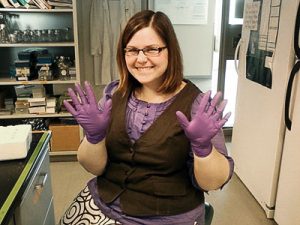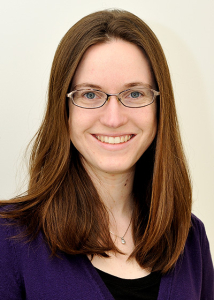Good news: almost 60 percent of all biology degrees (bachelor’s, master’s, and doctorates) are earned by women. But there’s a downside to this incredible statistic: work-life imbalance, a lack of female role models and mentors, and a scarcity of tenure-track positions in the sciences are causing these educated women to consider other possibilities. Fortunately, two Scripps College alumnae are working to curb this trend.
Kayly Lembke ’10 and Julia Maxson ’05 are co-founders of Women in Science, an organization of female graduate students and post-doctoral fellows at Oregon Health and Science University (OHSU) providing professional development opportunities to women aspiring to break through the barriers of the traditionally male-dominated science fields. It’s inspired by a similar group of the same name at Scripps, says Lembke.
“My undergraduate experience definitely played a role in how I approached this endeavor,” says Lembke, a biochemistry major now in her fourth year as a doctoral candidate in the molecular and cellular biology program. “Women in Science is a dynamic force on campus, very much in keeping with the Scripps spirit.”
Nationally, a growing number of female graduate students pursue advanced degrees in the sciences. As a result, the National Science Foundation has called for the creation of a national initiative aimed at retaining the number of women pursuing graduate degrees in the sciences. Retention of these women is challenging, in part, because many struggle to maintain a balance between the demands of their research and the desire to begin a family, according to Lembke.
“Typically, female science students enroll in graduate school during the same years they are most likely to have children,” Lembke says. “Many struggle with this inherent pull to either become new mothers or ambitious scientists – and when these women find it difficult to do both, many decide to opt out of a career in research.”
A report from the National Research Council reveals that, from 1999 to 2003, women were awarded 45 percent of all doctorate degrees in biology. However, only 39 percent of assistant professors in biology were women in 2003. Lembke believes her group can help female scientists navigate the divide.
“Women in Science has been extremely successful in connecting graduate students, post-docs, staff, and faculty,” says Lembke. “We examine a variety of topics from the challenges of maintaining a work-life balance, to understanding intellectual property laws, to women-centered negotiation skills.”
Soon after adopting a mission statement, the group tackled its first concern: the need for paid maternity leave for graduate students. They were successful, and OHSU now offers graduate students six weeks maternity leave and a framework on how the graduate student and her mentor can stay on course with academic research during a leave.
Maxson, who recently moved to Seattle to pursue a postdoctoral research opportunity, credits her experiences at Scripps as imbuing her with the confidence she needed to pursue a career in science.
“Living ‘confidently, courageously and hopefully’ describes not only Scripps women, but also Women in Science,” says Maxson, who majored in biology at Scripps. “I want to be surrounded by the best and brightest scientific colleagues, and that requires retaining junior scientists with families. Many institutions are working hard to retain these talented women, and the Women in Science is an essential group to help support that goal.”



